- Conditions
- Climber's finger
Climber's finger Pulley injury / pulley rupture / pulley tear
Introduction
Climber's finger is a common injury that is seen in almost all climbing sports. The pain is located on the front of one or more fingers.
The middle finger and/or ring finger are affected in the vast majority of cases. This is due to the fact that these fingers carry the largest share of the body weight during climbing. Other fingers may also be affected, however this is much less common.

Description of condition
The tendons that bend the fingers are located on the front of the hand. They are securely attached with a type of ring band, in order to keep them close to the bone during flexing movements. We call these pulleys. Without the pulleys, the flexor tendons of the hand would not remain beside the bone during (flexing) movements and would shoot forward (bowstringing).
If one or more pulleys are partially or completely ruptured, we call this climber's finger or pulley rupture. The typical "bowstringing" effect can occur when there is a total rupture of several pulleys. The flexor tendon separates from the bone during flexing movements, causing the bone and the tendon to form a crossbow figure. The A2 and A4 pulley appear to be affected more frequently than the other pulleys.
Cause and history
The symptoms occur as a result of a climber slipping or almost falling when climbing. The climber instinctively tries to break the fall by grabbing hold of a ledge. This exerts a sudden massive force on the flexor tendons and the pulleys. The pulleys are only able to absorb a limited amount of force. If the force on a pulley becomes too great, it will rupture partially or completely. An obvious "snap" is felt if the pulley ruptures acutely.
Repetitive (small) overloading while climbing can also cause gradual damage to the pulleys. Small tears make the pulley more sensitive and vulnerable.
Signs & symptoms
- Pain along the front of the finger.
- Swelling can occur, particularly with acute injuries.
- Pressing on the affected pulley is painful.
- Bending the fingers against resistance is painful.
- "Bowstringing" is visible when pulleys A2 through A4 are ruptured.
Diagnosis
If a physical examination does not provide clarity, the diagnosis can be confirmed using an ultrasound or MRI.
Treatment and recovery
Depending on the nature of the injury either conservative or surgical treatment may be applied. The literature includes the following treatment methods:
- Rest
- Splinting
- Taping
- NSAIDs
- Surgical reconstruction of the ruptured pulley(s).
More info
You can check your symptoms using the online physiotherapy check or make an appointment with a physiotherapy practice in your locality.
References
Kubiak, E.N., Klugman, J.A. & Bosco, J.A. (2006) Hand injuries in rock climbers Bull NYU Hosp Jt Dis. 2006;64(3-4):172-7..
Rondeel, J.M.M. & Wey, L.P. van der (1996) De klimvinger: vingerblessures bij sportklimmers Ned Tijdschr Geneeskd. 1996;140:1543-7.
Cupido, C. (2009) Finger pulley injuries. What to do about them Gripped. 2009;10(06):40-41.


